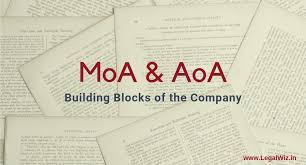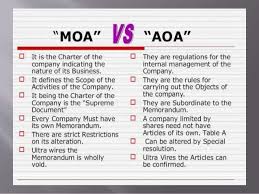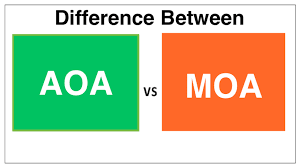
General Difference Between MOA and AOA
In general terms, the difference between MOA and AOA is that the Memorandum of Association (MOA) is a legal document that sets out the fundamental principles and objectives of a company. It includes details such as the company name, registered office, objects or purposes of the company, authorized share capital, and the liability of members. The MOA defines the scope of activities that the company is authorized to undertake and provides a framework for its operation.
The Articles of Association (AOA), on the other hand, are a set of rules and regulations that govern the internal management and administration of a company. The AOA typically covers matters such as the appointment and powers of directors, meetings of shareholders, issue and transfer of shares, dividends, and borrowing powers. It provides a framework for the day-to-day operation of the company and ensures that the interests of shareholders and other stakeholders are protected.
Table of Contents

Main Difference Between MOA and AOA
While both MOA and AOA are important legal documents for a company, they serve different purposes and contain different types of information. The MOA sets out the overall objectives and scope of the company, while the AOA lays down the internal management and governance rules for the company. Setting out the difference between MOA and AOA.
- Purpose: The MOA sets out the fundamental objectives, powers, and scope of the company, while the AOA lays down the rules and regulations for the internal management and governance of the company.
- Contents: The MOA includes details such as the company name, registered office, objects or purposes of the company, authorized share capital, and the liability of members. The AOA typically covers matters such as the appointment and powers of directors, meetings of shareholders, issue and transfer of shares, dividends, and borrowing powers.
- Alteration: The MOA can be altered only by passing a special resolution and with the approval of the Registrar of Companies, while the AOA can be amended by passing an ordinary resolution.
- Binding nature: The MOA is binding on the company and its members, and any actions taken by the company must be within the scope of the objects specified in the MOA. The AOA is binding on the company, its members, and its officers, and must be adhered to in the day-to-day management and governance of the company.
- Public document: The MOA is a public document and can be accessed by anyone who wishes to do so. The AOA is also a public document, but it may contain provisions that are specific to the company and may not be relevant to outsiders.

Pointwise Difference Between MOA and AOA
Here are the pointwise differences between MOA and AOA:
MOA:
- MOA is a document that sets out the fundamental principles and objectives of a company.
- It includes details such as the company name, registered office, objects or purposes of the company, authorized share capital, and the liability of members.
- MOA defines the scope of activities that the company is authorized to undertake and provides a framework for its operation.
- MOA cannot be altered easily and requires the approval of the Registrar of Companies.
- MOA is a public document and can be accessed by anyone who wishes to do so.
AOA:
- AOA is a document that contains rules and regulations for the internal management and administration of a company.
- It typically covers matters such as the appointment and powers of directors, meetings of shareholders, issue and transfer of shares, dividends, and borrowing powers.
- AOA provides a framework for the day-to-day operation of the company and ensures that the interests of shareholders and other stakeholders are protected.
- AOA can be altered by passing an ordinary resolution.
- AOA is a public document and can be accessed by anyone who wishes to do so.
In summary, MOA defines the objectives and scope of a company, while AOA outlines the internal management and governance structure of the company. MOA is difficult to alter, while AOA can be amended by passing an ordinary resolution. Both documents are public documents and can be accessed by anyone who wishes to do so.
Table-wise Difference Between MOA and AOA
| MOA | AOA |
|---|---|
| It is a document that sets out the fundamental principles and objectives of a company. | It is a document that contains rules and regulations for the internal management and administration of a company. |
| It includes details such as the company name, registered office, objects or purposes of the company, authorized share capital, and the liability of members. | It typically covers matters such as the appointment and powers of directors, meetings of shareholders, issue and transfer of shares, dividends, and borrowing powers. |
| MOA defines the scope of activities that the company is authorized to undertake and provides a framework for its operation. | AOA provides a framework for the day-to-day operation of the company and ensures that the interests of shareholders and other stakeholders are protected. |
| MOA cannot be altered easily and requires the approval of the Registrar of Companies. | AOA can be altered by passing an ordinary resolution. |
| MOA is a public document and can be accessed by anyone who wishes to do so. | AOA is a public document and can be accessed by anyone who wishes to do so. |
What is MOA?
As per the Companies Act 2013, MOA (Memorandum of Association) is a legal document that defines the scope of activities that a company is authorized to undertake. It contains the fundamental principles and objectives of the company and sets out the rules and regulations that govern its operation.
The MOA includes important details such as the name of the company, its registered office, the objects for which the company is formed, the authorized share capital, and the liability of its members.
Under the Companies Act 2013, the MOA must be drafted in accordance with the prescribed format and must be signed by the subscribers in the presence of at least one witness who shall attest to the signature. The MOA must also be filed with the Registrar of Companies (ROC) at the time of incorporation, along with the AOA (Articles of Association) and other necessary documents.
The MOA is an important legal document that governs the activities of a company and serves as a guide to its operations. It defines the scope of activities that the company is authorized to undertake and provides a framework for its operation. The MOA cannot be altered easily and requires the approval of the ROC.
What is AOA?
AOA stands for Articles of Association. In the context of company law, it refers to a legal document that defines the rules and regulations governing the internal management of a company.
The Articles of Association are one of the two key documents that together form the constitution of a company, the other being the Memorandum of Association. The AOA specifies the rights and duties of shareholders, directors, and other officers of the company, as well as the procedures for conducting meetings, issuing shares, and making important decisions.
Under the Companies Act, 2013 of India, the Articles of Association are governed by Section 2(5), Section 5, Section 14, Section 15, Section 16, Section 17, and Section 18. Additionally, there are various rules and regulations under the Act that prescribe the format and content of the Articles of Association for different types of companies. For example, the Companies (Incorporation) Rules, 2014 specifies the model articles of association for different types of companies, which can be adopted or modified by the company as per their requirements.

Similarities Between MOA and AOA
Apart from the Difference Between MOA and AOA, Here are some similarities between MOA (Memorandum of Association) and AOA (Article of Association):
- Both MOA and AOA are legal documents that are required to be filed with the Registrar of Companies (ROC) at the time of incorporation of a company.
- Both MOA and AOA are public documents that can be accessed by anyone who wishes to do so.
- Both MOA and AOA are binding on the company, its shareholders, and its directors.
- Both MOA and AOA serve as a guide to the operations of the company.
- Both MOA and AOA must comply with the requirements of the Companies Act and other applicable laws and regulations.
- Both MOA and AOA are important legal documents that define the rights, duties, and obligations of the company, its shareholders, and its directors.
In summary, both MOA and AOA are legal documents that are required to be filed with the ROC, are public documents, are binding on the company and its stakeholders, serve as a guide to the operations of the company, must comply with applicable laws and regulations, and define the rights, duties, and obligations of the company, its shareholders, and its directors.
How to alter the MOA of the Company?
The process to alter the MOA (Memorandum of Association) of a company is governed by the Companies Act 2013 and the rules made thereunder. Here’s a general procedure for altering the MOA:
- Convene a Board Meeting: The first step is to convene a board meeting of the company and pass a resolution to propose the alteration to the MOA. The resolution should specify the reasons for the proposed alteration and the effect of such alteration on the company.
- Call a General Meeting: Once the board has passed the resolution, the company must call a general meeting of its shareholders and pass a special resolution to approve the proposed alteration to the MOA. A special resolution requires a three-fourths majority of the votes cast by the shareholders.
- File Form MGT-14: After the special resolution is passed, the company must file Form MGT-14 with the Registrar of Companies (ROC) within 30 days of passing the resolution. This form contains details of the proposed alteration to the MOA and is accompanied by a copy of the altered MOA.
- Obtain Approval of the ROC: The ROC will review the application and if it is satisfied that the alteration is in compliance with the Companies Act and rules made thereunder, it will approve the alteration and issue a certificate of registration of the altered MOA.
- Update the MOA: Once the certificate of registration is issued, the company must update its MOA by incorporating the alteration and filing the updated MOA with the ROC.
How to alter the AOA of the Company?
The process to alter the AOA (Articles of Association) of a company is governed by the Companies Act 2013 and the rules made thereunder. Here’s a general procedure for altering the AOA:
- Convene a Board Meeting: The first step is to convene a board meeting of the company and pass a resolution to propose the alteration to the AOA. The resolution should specify the reasons for the proposed alteration and the effect of such alteration on the company.
- Call a General Meeting: Once the board has passed the resolution, the company must call a general meeting of its shareholders and pass a special resolution to approve the proposed alteration to the AOA. A special resolution requires a three-fourths majority of the votes cast by the shareholders.
- File Form MGT-14: After the special resolution is passed, the company must file Form MGT-14 with the Registrar of Companies (ROC) within 30 days of passing the resolution. This form contains details of the proposed alteration to the AOA and is accompanied by a copy of the altered AOA.
- Obtain Approval of the ROC: The ROC will review the application and if it is satisfied that the alteration is in compliance with the Companies Act and rules made thereunder, it will approve the alteration and issue a certificate of registration of the altered AOA.
- Update the AOA: Once the certificate of registration is issued, the company must update its AOA by incorporating the alteration and filing the updated AOA with the ROC.
It is important to note that certain alterations to the AOA require additional approvals, such as the approval of the National Company Law Tribunal (NCLT). Companies should therefore consult with legal professionals and follow the prescribed procedures for altering the AOA.
References used in Difference Between MOA and AOA
https://www.academia.edu/29107396/Difference_between_MOA_and_AOA
